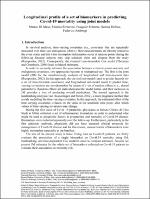Chapter Longitudinal profile of a set of biomarkers in predicting Covid-19 mortality using joint models
Author(s)
Ferrante, Pasquale
Di Maso, Matteo
Ferraroni, Monica
Delbue, Serena
Ambrogi, Federico
Language
EnglishAbstract
In survival analysis, time-varying covariates are endogenous when their measurements are directly related to the event status and incomplete information occur at random points during the follow-up. Consequently, the time-dependent Cox model leads to biased estimates. Joint models (JM) allow to correctly estimate these associations combining a survival and longitudinal sub-models by means of a shared parameter (i.e., random effects of the longitudinal sub-model are inserted in the survival one). This study aims at showing the use of JM to evaluate the association between a set of inflammatory biomarkers and Covid-19 mortality. During Covid-19 pandemic, physicians at Istituto Clinico di Città Studi in Milan collected biomarkers (endogenous time-varying covariates) to understand what might be used as prognostic factors for mortality. Furthermore, in the first epidemic outbreak, physicians did not have standard clinical protocols for management of Covid-19 disease and measurements of biomarkers were highly incomplete especially at the baseline. Between February and March 2020, a total of 403 COVID-19 patients were admitted. Baseline characteristics included sex and age, whereas biomarkers measurements, during hospital stay, included log-ferritin, log-lymphocytes, log-neutrophil granulocytes, log-C-reactive protein, glucose and LDH. A Bayesian approach using Markov chain Monte Carlo algorithm were used for fitting JM. Independent and non-informative priors for the fixed effects (age and sex) and for shared parameters were used. Hazard ratios (HR) from a (biased) time-dependent Cox and joint models for log-ferritin levels were 2.10 (1.67-2.64) and 1.73 (1.38-2.20), respectively. In multivariable JM, doubling of biomarker levels resulted in a significantly increase of mortality risk for log-neutrophil granulocytes, HR=1.78 (1.16-2.69); for log-C-reactive protein, HR=1.44 (1.13-1.83); and for LDH, HR=1.28 (1.09-1.49). Increasing of 100 mg/dl of glucose resulted in a HR=2.44 (1.28-4.26). Age, however, showed the strongest effect with mortality risk starting to rise from 60 years.
Keywords
Endogenous time-varying covariates; Time-dependent Cox model; Joint models; Inflammatory biomarkers; Covid-19 mortalityDOI
10.36253/978-88-5518-461-8.36ISBN
9788855184618, 9788855184618Publisher
Firenze University PressPublisher website
https://www.fupress.com/Publication date and place
Florence, 2021Series
Proceedings e report, 132Classification
Social research and statistics


 Download
Download Web Shop
Web Shop